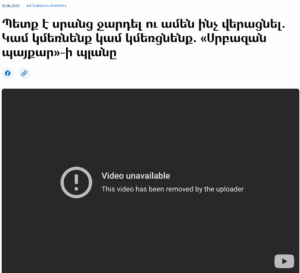
When seeking information about the Caucasus, especially from France, people often face several challenges beyond the language barrier: where to find reliable information, what sources to trust, and how to make sense of this complex region. The fast-moving news cycle combined with new ways of consuming media—as thoroughly explored in Jonathan Hendrickx’s 2024 study1HENDRICKX Jonathan. “‘Normal news is boring’: How young adults encounter and experience news on Instagram and TikTok”. New Media and Society. May 2024. Link to the article—adds even more complexity. He identifies three major paradigm shifts. The first, the ‘spatial shift,’ describes how information is now accessed instantly on mobile platforms, prioritizing convenience, speed, and ease of access on apps like Instagram and TikTok. The second, the ‘emotional turn,’ recognizes journalism’s move away from detached objectivity toward emotionally engaging content that connects with audiences. Finally, the ‘audience turn’ marks a fundamental change: audiences are no longer seen as passive consumers or problems, but as active participants essential to journalism’s democratic role, with their own lived experiences shaping how they interact with information. In addition, new forms of warfare have emerged—most notably during the 2020 Forty-Four Day War—where an online front has been opened up to sow discord among populations.
Armenia faces crises on multiple fronts, which deeply impact knowledge production and public discourse. The region’s tense political climate creates fertile ground for all types of news, ranging from deliberate disinformation to mistakes that can linger uncorrected. On the domestic front, political turmoil has had similar effects. Recently, the so-called attempted putsch by the Church triggered widespread attention and debate. On June 25, 2025, Bishop Bagrat Galstanyan, an opposition figure, and several supporters were arrested in Yerevan on charges of attempting a coup against Nikol Pashinyan’s government. Authorities released photos of firearms allegedly found at the scene. In the following days, numerous articles appeared, often strongly taking one side or the other.
Beyond Church supporters or conservatives, many questioned the accusations due to a profound lack of trust in the authorities, as highlighted by the last two reports from the International Republican Institute from October 20242“Public Opinion Survey: Residents of Armenia. International Republican Institute. October 2024. Link to the website and June 20253Public Opinion Survey: Residents of Armenia”. International Republican Institute. June 2025. Link to website. Each year, this institute surveys residents about their views on the country’s policies. In 2024, 46% of respondents believed the country was headed in the right direction, while 40% disagreed. By 2025, the trend reversed: 49% now feel the country is moving in the wrong direction, compared to only 36% who think otherwise, confirming a clear decline in trust. When asked “Which politician or political figure do you trust most? And in second place?”, 2024’s top answer was “nobody” with 60%, while Nikol Pashinyan garnered only 14%. In 2025, this mistrust deepened: 61% have confidence in no one, and Pashinyan’s approval dropped to 12%. Notably, just 1% of respondents placing another figure first also ranked Pashinyan second. These numbers starkly illustrate the political divisions fracturing the country.

Despite the controversy, several articles emerged supporting or revealing the coup attempt. ArmTimes, a newspaper run by Anna Hakobyan, wife of Nikol Pashinyan—which raises questions about press independence—published an article the very next morning presenting the events as factual, without using any conditional language4“Բագրատ Գալստանյանը կալանավորվել է”. ArmTimes. 26 June 2025. Link to article. That same evening, Azatutyun5“Armenian Protest Leader, Supporters, Arrested in ‘Coup’ Probe (UPDATED)”. Azatutyun. 26 June 2025. Link to article published a piece casting doubt on the official narrative after consulting Galstanyan’s lawyer. They also highlighted inconsistencies in a conspirators’ plan document revealed by civic.am, a website affiliated with the ruling party. That document appears to have since been removed from the site.
Given this complex situation, one key question remains for readers: who is telling the truth? While everyone is entitled to their own opinion, based on the currently available information, it is impossible to definitively answer. It is also important to remember that future revelations may not fully vindicate either side. For an event of this scale, it is unrealistic to expect a comprehensive understanding in the immediate aftermath.
To answer the question posed in the title, the depth and breadth of divisions within Armenian society at every level mean that anyone seeking clarity must exercise patience. Fully understanding these events requires cross-referencing sources—some of which remain unavailable due to ongoing investigations—and verifying the authenticity of available documents. Access to certain confidential state archives is also necessary. It often takes months or even years to truly grasp the dynamics behind political destabilization. The media’s rapid pace, the immediacy of reporting, and the intensity of accusations—with one group accusing the other of a genuine coup attempt, and the opponents accusing the government of having framed them—combine to create a particularly complex picture. This is why API chose not to rush into publishing a report on the matter. We will, however, keep our readers updated as the situation evolves.
